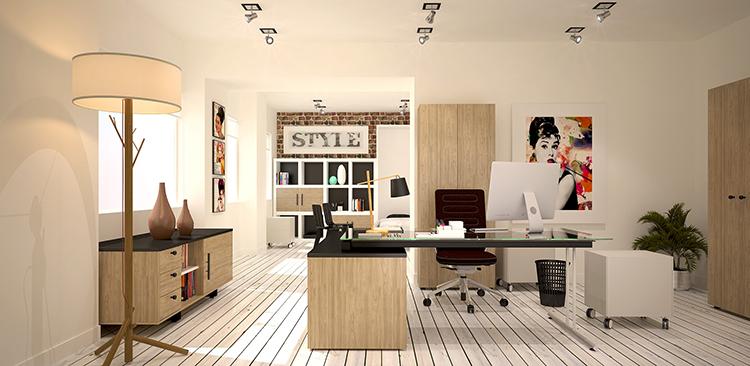According to the Bureau of Labor Statistics, close to 25 percent of all employed Americans work from home at least some of the time. This is hardly surprising given increasingly longer commutes and the growth of the gig economy. If you’re part of this trend of telecommuters, you probably already know that working from home has its upsides and downsides. The key to staying on task while surrounded by the distractions of home is to create a home office where you can be your most productive. Let’s go through the steps.

As telecommuting gets simpler, dedicated home office spaces have become more important for homeowners. Photo: Closet Factory (2017)
Step 1: Establish Your Work Station
If you’re lucky enough to have a dedicated room for a home office, you’re already set. Many telecommuters need to creatively carve out an office area from part of a bedroom or dining room. Organizing a “multi-purpose” room may be tricky, but home organization professionals can help you find a solution that’s both practical and attractive. Even in a smaller work station, consumer advocate Chris Bjorklund recommends using as large a surface area as possible for your desk (a corner desk would be a great solution) and placing cabinets overhead to better utilize a smaller space. If your “home office” is actually the local coffee shop, you’ll still need a home base for storing backups of your work and other essential documents.
Step 2: Meet Your Tech Requirements
A modern home office requires a lot of connectivity. Make sure your new work station can handle increased electrical activity and consult with an electrician if you need to make upgrades. If you’ll be regularly streaming large amounts of data through the Internet (video conference calls, transferring files), you’ll need to ensure there’s adequate Internet bandwidth. Working from home usually requires a VPN connection to link up with the rest of your office, which may slow down your connection speed in certain circumstances. Contact your Internet service provider or office IT staff if you have any concerns.
Step 3: Secure Your Home Office
There are two types of security you need to think about with your home office: security for the physical space and security for your data. Start by putting high-quality locks on your office door and any filing cabinets that contain sensitive information. Depending on your office’s size and the types of information you have at home, it may be wise to set up an alarm system. You also need to take steps to keep your data secure. Find a trusted antivirus software and routinely back up your computer. Experts agree that using both a physical backup (such as a USB key) and cloud-based storage is best. In a worst-case scenario like physical damage to your computer, there are companies that specialize in data recovery.
Step 4: Get Rid of Distractions
Working from home means enjoying the freedom of sweatpants but suffering the constant distractions and temptations that come from other parts of your house. Stay productive by isolating yourself from outside noises. To block out distracting sounds like neighbors, traffic and barking dogs, try using noise-cancelling headphones. If headphones are impractical or you need a deeper level of isolation, consider investing in increased insulation or soundproofing for the walls.
Step 5: Add Your Personal Touches
A home office is a space for self-expression. No longer confined to the ochre ocean of cubicle life, you can let your imagination run free as you create a workspace that inspires you. Designing and decorating a new office space can be as large or small a project as you wish. Even a little bit of effort can result in a huge transformation of your space. Painting a single wall, reupholstering furniture, or adding shelves or art to your walls can make a room feel refreshed. Diamond Certified interior designers, painters, upholsterers and handymen can help you create an office where you’ll be excited to work.
Step 6: Remember the Bottom Line
Don’t forget about your home office when preparing your taxes. Diamond Certified Expert Contributor Virginia Passarell of Passarell Tax & Bookkeeping Services reminds her clients that if any part of their home is used solely for work-related activities, they can take that as a deduction, even if it’s just a corner. If you’re worried that deducting a home office could catch the attention of the IRS, Ms. Passarell says there’s no reason not to take every legitimate deduction that’s available.
One Response
Leave a Reply
You must be logged in to post a comment.

Having a dedicated area away from distractions is very important indeed